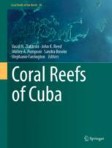Search
Search Results
-
A new type of Halimeda bioherm on the Queensland Plateau, NE Australia
Morphology, internal structure, and in situ facies distribution of mesophotic Halimeda bioherms from the Queensland Plateau (NE Australia) are...

-
Discovery of the dendrophylliid scleractinian Heteropsammia cochlea (Spengler, 1781) in Halimeda bioherms of the Northern Great Barrier Reef
Halimeda bioherms on the Northern Great Barrier Reef (GBR) extend for over 6000 km 2 . To explore the ecological and biogeographical importance of...

-
Halimeda opuntia and Padina pavonica extracts improve growth and metabolic activities in maize under soil-saline conditions
There is no doubt that at the recent years scientists are seeking for using safe, cheap, environment friendly methods in agriculture. One of these...

-
Geometric morphometrics shows a close relationship between the shape features, position on thalli, and CaCO3 content of segments in Halimeda tuna (Bryopsidales, Ulvophyceae)
Calcifying green algae of the genus Halimeda J.V. Lamouroux are typical for the modular thalli composed of serial segments. Their CaCO 3 content...

-
Inter-reef Halimeda algal habitats within the Great Barrier Reef support a distinct biotic community and high biodiversity
Tropical marine biodiversity studies have been biased towards more accessible coastal habitats and shallow coral reefs, while deeper inter-reef...

-
Cue selection and ontogeny reveal larval settlement dynamics of the long-spined sea urchin Diadema antillarum, a keystone coral reef herbivore
Understanding early life histories of keystone marine herbivores can broaden insight into population dynamics and ecosystem functioning. Settlement,...

-
Seaweed extracts as biological control of aflatoxins produced by Aspergillus parasiticus and Aspergillus flavus
BackgroundMycotoxins are secondary metabolites made by a variety of molds and fungi. They contaminate a lot of food products and local crops during...

-
Early successional trajectory of benthic community in an uninhabited reef system three years after mass coral bleaching
Severe thermal stress events occurring on the backdrop of globally warming oceans can result in mass coral mortality. Tracking the ability of a reef...

-
Tracing nitrate sources using the isotopic composition of skeletal-bound organic matter from the calcareous green algae Halimeda
The nitrogen (N) isotopic composition (δ 15 N) of water column nitrate (NO 3 − ) reveals important information about the source(s) of N, and/or the...

-
Macroalgal susceptibility to grazing by herbivore fish Siganus spp. at Gulf of Mannar reef, Indian Ocean
Enhancing the herbivore fish stock is envisaged as a mitigation tool to reverse the macroalgal dominance in a coral reef environment. However,...

-
Stable carbon and oxygen isotopes indicate photophysiology and calcification mechanisms of macroalgae on Little Cayman Island reefs
Tropical macroalgae serve importance ecological roles on coral reefs but can supplant corals in phase shifts as shown worldwide. Thus, it is...

-
Crawl away from the light! Assessing behavioral and physiological photoprotective mechanisms in tropical solar-powered sea slugs exposed to natural light intensities
Photosynthesizers face a trade-off regarding light: they need enough to maintain high photosynthetic rates, yet excess leads to oxidative stress....

-
Implications of changing Caribbean coral reefs on Diadema antillarum larvae settlement
Tropical western Atlantic reefs have gradually shifted from being dominated by corals to being mainly covered by macroalgae. The mass-mortality of...

-
Reassessing the role of herbivores on urban coral reefs: A case study from a heavily impacted reef near Cartagena Bay, Colombia
Coral reefs are beginning to experience conditions unlike any in recent history. Understanding ecosystem function on future reefs will require...

-
The Modern Times
Scleractinian reefs developed over the Quaternary era–the last 2.8 million years–are regarded herein as modern. First, are presented the main...
-
Macrophytes Associated with Cuban Coral Reefs
Macrophytes constitute an important component of coral reef communities. This chapter will review the knowledge of macroalgae and marine angiosperms...
-
Diversity of squat lobsters on coral reefs in Guam, Mariana Islands, with the description of two new species and notes on their natural history
Squat lobsters (family Galatheidae Samouelle,
1819 ) inhabiting shallow reefs are small crustaceans that can exhibit bright colors and include many...
-
Total polyphenol content of tropical marine and coastal flora: Potentials for food and nutraceutical applications
The marine environment is abundant in natural products that are beneficial to humans. Among these compounds are the polyphenols produced by marine...

-
Microbiomes and metabolomes of dominant coral reef primary producers illustrate a potential role for immunolipids in marine symbioses
The dominant benthic primary producers in coral reef ecosystems are complex holobionts with diverse microbiomes and metabolomes. In this study, we...

-
Mesophotic Coral Ecosystems of Cuba
This chapter reviews the current knowledge regarding Cuba’s mesophotic coral ecosystems (MCEs). The first studies of MCEs in Cuba were conducted by...
